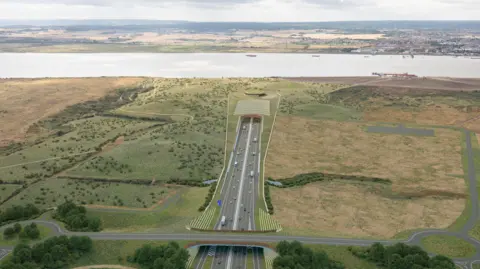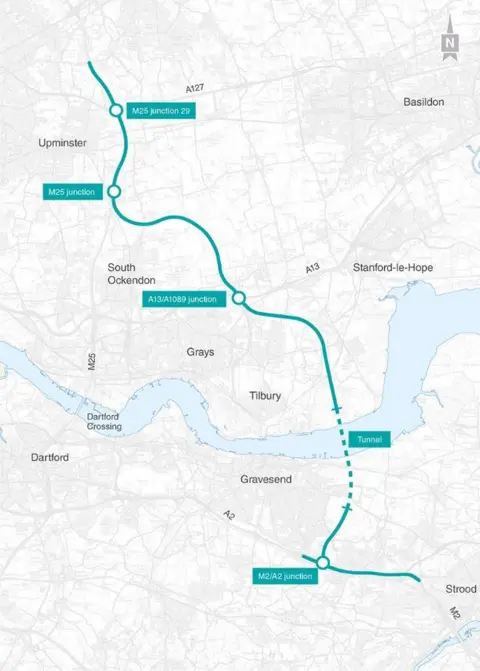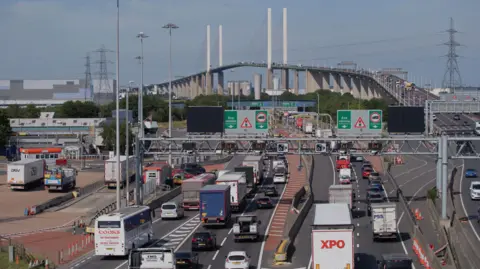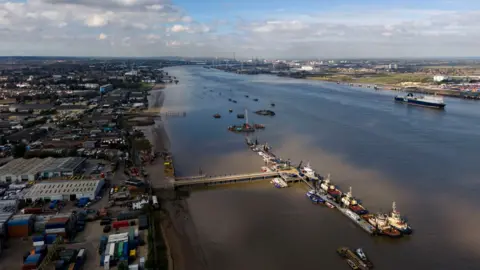Decision on new £8.3bn Thames Crossing delayed
 National Highways
National HighwaysA decision on whether to proceed with a new £8.3bn tunnel under the Thames estuary will not be made before next week, the government has said.
The Lower Thames Crossing project has been worked on for 15 years and £850m has been spent on planning so far.
The statutory deadline for a decision was 4 October but the Department for Transport (DfT) said an update would be given "in due course".
National Highways said the creation of a new motorway-style road would "almost double capacity" across the Thames east of London between Essex and Kent.
A DfT spokesperson added: "We cannot comment any further on a live application."
 National Highways
National HighwaysThere has been opposition from some councils, campaigners and politicians over the construction of a new 14-mile (22.5km) road through green belt land.
It is understood Parliament will be updated on the decision when it returns from recess on Monday.
In the summer, Chancellor of the Exchequer Rachel Reeves cancelled several major infrastructure projects, including a new road tunnel at Stonehenge, to save billions of pounds.
However, the Lower Thames Crossing project was not axed. If approved it would be one of the largest infrastructure projects in the UK.
The new road would link the A2 and M2 in Kent via a 2.6 mile (4.1km) tunnel to the A13 in Thurrock in Essex, which would also connect to the M25 at its junction 29 with the A127.
 National Highways
National HighwaysIn Essex, the three-lane dual carriageway would be constructed on green belt land north of South Ockendon.
The Thames Crossing Action Group has said the new crossing would "destroy" the green belt and people's health.
Thurrock MP Jen Craft warned it "would be a disaster for Thurrock on an environmental and a social level and even on the best possible estimates will not alleviate the issues caused by congestion on the current Dartford Crossing".
Thurrock Council has long been opposed, but the leader of Dartford Council in Kent is in favour.
John Burden, leader of neighbouring Gravesham Borough Council, which covers Gravesend, said any delay was "frustrating news".
"What we and our local community need is certainty, one way of the other," he said.
"I hope the decision will be forthcoming at the earliest opportunity."
'Congestion, delays and disruption'
However, the Essex Chambers of Commerce said the 700 firms it represented "overwhelmingly" supported a new crossing.
Chief executive Denise Rossiter said: "Many have seen their businesses and economic growth constrained for many years by the congestion, delays and disruption caused by reliance on the existing crossing at Dartford.
"The new crossing would significantly reduce these problems and help to open up the economy of the South East and the UK more widely."
National Highways said there would be a 20% reduction in traffic at the Dartford Crossing, which takes the M25 across the Thames just east of the capital, once the new one opened.
 Jordan Pettitt/PA Media
Jordan Pettitt/PA MediaIf construction goes ahead, Blackwell Earthmoving stands to benefit as about 26 million tonnes of earth will need to be moved as part of the project.
Albert Moyo, project director, said that about 300 of its staff would be involved in the earth excavations on the Essex side.
"We might have to recruit and train engineers and people to drive our machines," he said.
"We are targeting local recruitment. We have committed to having 60% being local."
If the government does approve it, construction is expected to begin in 2026 with the new road opening in 2032.
Follow Essex news on BBC Sounds, Facebook, Instagram and X.
